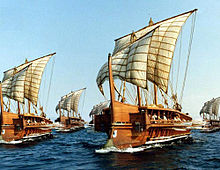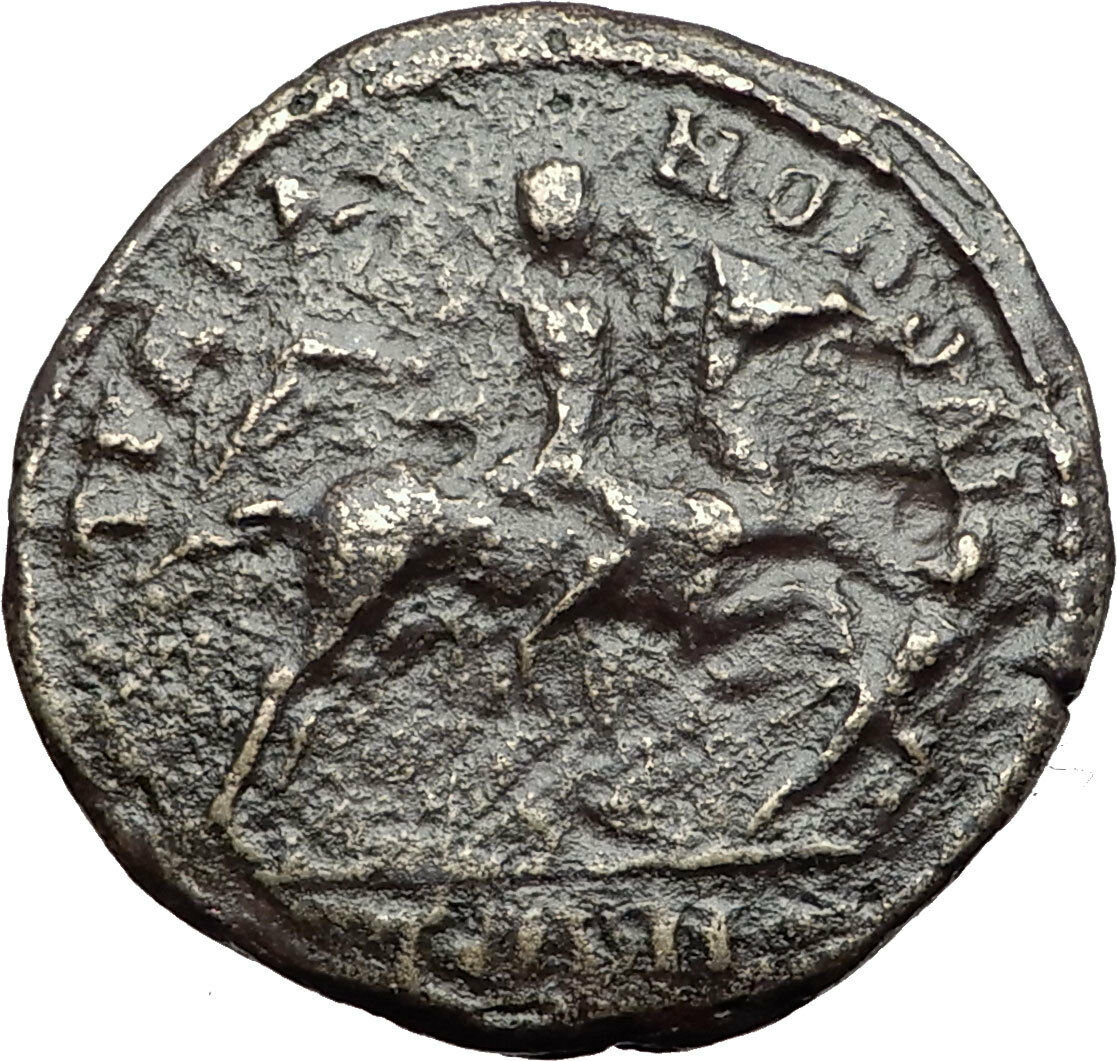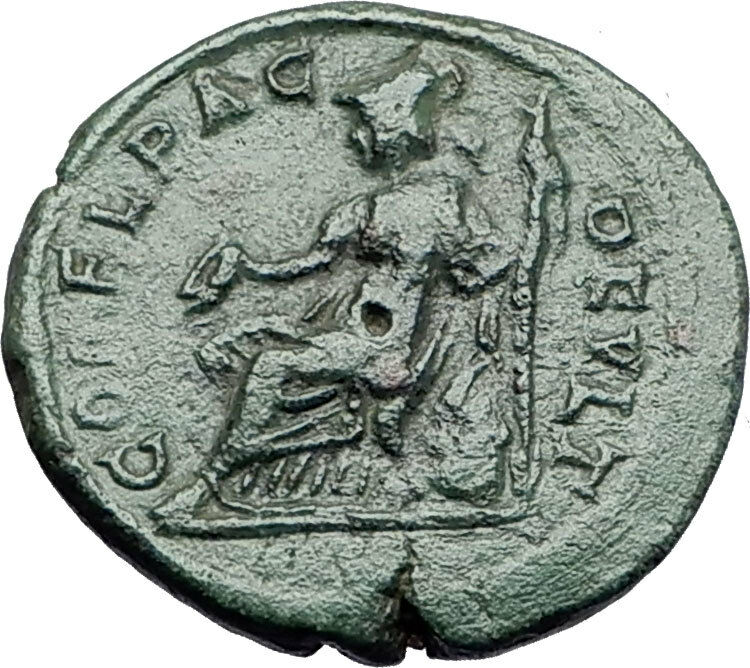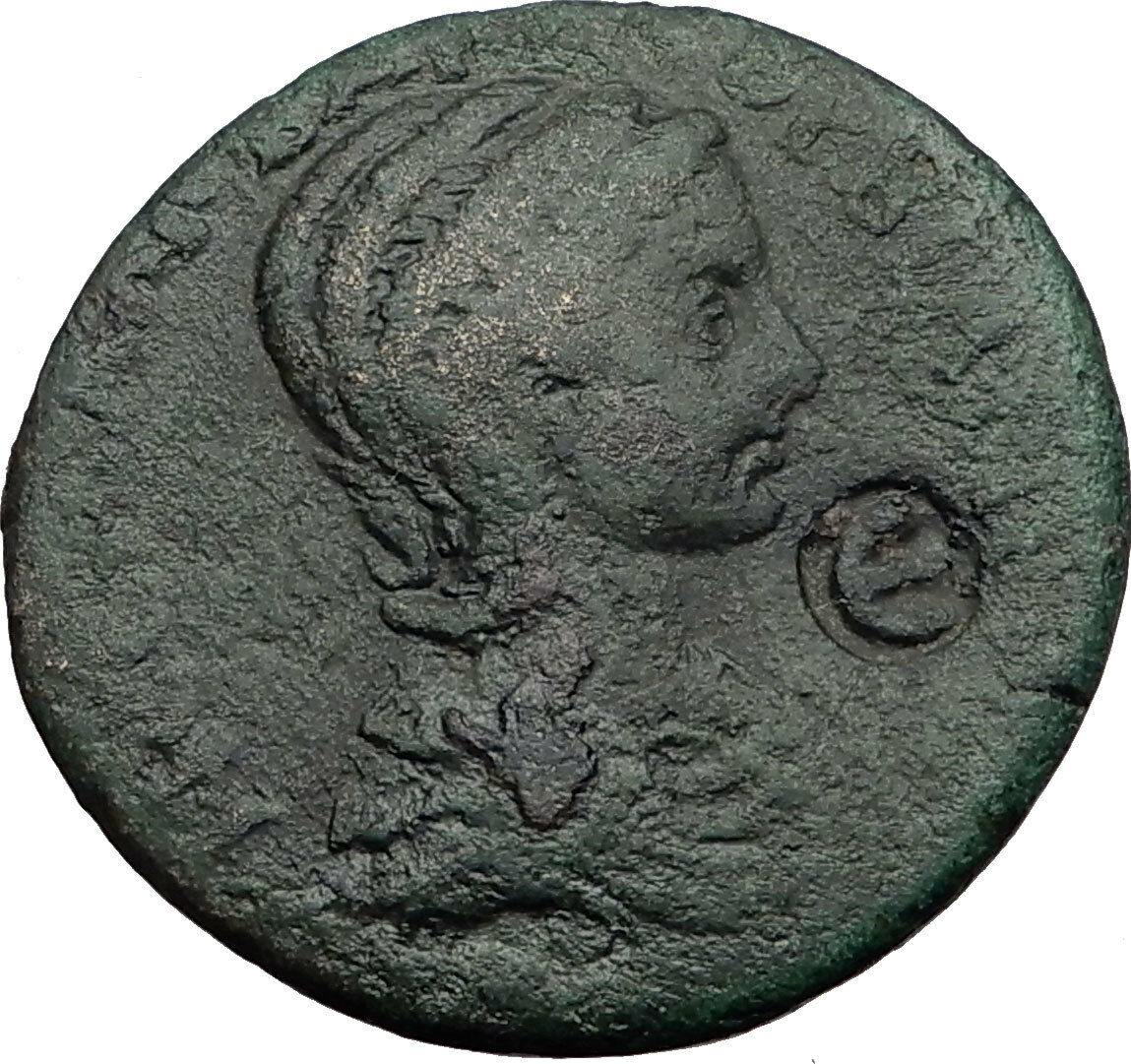|
Septimius Severus
–
Roman Emperor
: 193-211 A.D. –
Bronze 18mm (3.44 grams) of
Coela
in
Thrace
Reference: Moushmov 5569
Laureate, draped and cuirassed bust right.
AEL MVNICIPI CVILA, prow right with corn ears (or palm branches) above and
dolphin swimming right below.
You are bidding on the exact item pictured,
provided with a Certificate of Authenticity and Lifetime Guarantee of
Authenticity.

A
galley is a type of
ship propelled by
rowers
that originated in the eastern
Mediterranean Sea
and was used for
warfare
,
trade
and
piracy
from the first millennium BC. Galleys
dominated
naval warfare
in the Mediterranean from the 8th
century BC until development of advanced sailing warships in the 17th century.
Galleys fought in the wars of
Assyria
, ancient
Phoenicia
,
Greece
,
Carthage
and
Rome
until the 4th century AD. After the fall
of the
Western Roman Empire
galleys formed the
mainstay of the
Byzantine navy
and other navies of successors
of the Roman Empire, as well as new
Muslim
navies. Medieval Mediterranean states,
notably the Italian maritime republics, including
Venice
,
Pisa
,
Genoa
and the
Ottoman Empire
relied on them as the primary
warships of their fleets until the 17th century, when they were gradually
replaced by sailing warships. Galleys continued to be applied in minor roles in
the Mediterranean and the
Baltic Sea
even after the introduction of
steam propelled
ships in the early 19th
century.
The galley engagements at
Actium
and
Lepanto
are among the greatest
naval battles
in history.
 Coela Coela
was located on the eastern part of the Thracian Chersonese, known in modern
times as the Gallipoli Peninsula. It struck coins during times of Alexander the
Great and later issued coins under the ancient Romans (known as Roman Provincial
or Greek Imperial coins.

The Gallipoli
peninsula
(Turkish:
Gelibolu
Yarımadası;
Greek
: Καλλίπολη)
is located in Turkish Thrace (or
East Thrace
), the European part of
Turkey
, with the
Aegean Sea
to the west and the
Dardanelles
strait to the east.
Gallipoli derives its name from the
Greek
“Καλλίπολις” (Kallipolis), meaning
“Beautiful City”. In
antiquity
, it was known as the Thracian
Chersonese, from
Greek
: Θρακική
Χερσόνησος (Latin:
Chersonesus Thracica).
The peninsula runs in a south-westerly direction into the
Aegean Sea
, between the Hellespont (now known
as the Dardanelles
) and the bay of Melas (today
Saros bay
). Near
Agora
it was protected by a wall running across
its full breadth. The isthmus traversed by the wall was only 36
stadia
in breadth (about 6.5 km), but the
length of the peninsula from this wall to its southern extremity, Cape Mastusia,
was 420 stadia (about 77.5 km).


Thrace
(demonym Thracian;
Bulgarian
:
Тракия, Trakiya,
Greek
: Θράκη,
Thráki,
Turkish
:
Trakya) is a historical and geographic area in southeast
Europe
. As a geographical concept, Thrace
designates a region bounded by the
Balkan Mountains
on the north,
Rhodope Mountains
and the
Aegean Sea
on the south, and by the
Black Sea
and the
Sea of Marmara
on the east. The areas it
comprises are southeastern
Bulgaria
(Northern
Thrace), northeastern
Greece
(Western
Thrace), and the European part of
Turkey
(Eastern
Thrace). The biggest part of Thrace is part of present-day Bulgaria.
In Turkey, it is also called
Rumelia
. The name comes from the
Thracians
, an ancient
Indo-European
people inhabiting Southeastern
Europe.
The historical boundaries of Thrace have varied. Noteworthy is the fact that,
at an early date, the
ancient Greeks
employed the term “Thrace” to
refer to all of the territory which lay north of
Thessaly
inhabited by the
Thracians
, a region which “had no definite
boundaries” and to which other regions (like
Macedonia
and even
Scythia
) were added. In one ancient Greek
source, the very Earth is divided into “Asia, Libya, Europa and Thracia”. As the
knowledge of world geography of the Greeks broadened, the term came to be more
restricted in its application: Thrace designated the lands bordered by the
Danube
on the north, by the Euxine Sea (Black
Sea) on the east, by northern
Macedonia
in the south and by the
Illyrian
lands (i.e.
Illyria
) to the west. This largely coincided
with the Thracian
Odrysian kingdom
, whose borders varied in time.
During this time, specifically after the Macedonian conquest, the region’s old
border with Macedonia was shifted from the
Struma River
to the
Mesta River
. This usage lasted until the Roman
conquest. Henceforth, (classical) Thrace referred only to the tract of land
largely covering the same extent of space as the modern geographical region. In
its early period, the
Roman province of Thrace
was of this extent,
but after the administrative reforms of the late 3rd century, Thracia’s much
reduced territory became the six small provinces which constituted the
Diocese of Thrace
. The medieval
Byzantine
theme
of
Thrace
contained only what today is
Eastern Thrace
.
The largest cities of Thrace are:
İstanbul
(European side),
Plovdiv
,
Burgas
,
Stara Zagora
,
Haskovo
,
Edirne
,
Çorlu
and
Tekirdag
.
Most of the Bulgarian and Greek population are Christians, while most of the
Turkish inhabitants of Thrace are Muslims.

The Roman province of Thrace
Thrace in
ancient Greek mythology
Ancient Greek mythology
provides them with a
mythical ancestor, named
Thrax
, son of the war-god
Ares, who was said to reside in Thrace. The Thracians appear in
Homer
‘s
Iliad
as
Trojan allies, led by
Acamas
and
Peiros
. Later in the Iliad,
Rhesus
, another Thracian king, makes an
appearance. Cisseus
, father-in-law to the Trojan elder
Antenor
, is also given as a Thracian king.
Homeric Thrace was vaguely defined, and stretched from the River
Axios
in the west to the
Hellespont
and
Black Sea
in the east. The
Catalogue of Ships
mentions three separate
contingents from Thrace: Thracians led by Acamas and Peiros, from
Aenus
;
Cicones
led by
Euphemus
, from southern Thrace, near
Ismaros
; and from the city of
Sestus
, on the Thracian (northern) side of the
Hellespont, which formed part of the contingent led by
Asius
. Greek mythology is replete with Thracian
kings, including
Diomedes
,
Tereus
,
Lycurgus
,
Phineus
,
Tegyrius
,
Eumolpus
,
Polymnestor
,
Poltys
, and
Oeagrus
(father of
Orpheus
). In addition to the tribe that Homer
calls Thracians, ancient Thrace was home to numerous other tribes, such as the
Edones
,
Bisaltae
,
Cicones
, and
Bistones
.
Thrace is also mentioned in Ovid’s Metamorphoses in the episode of
Philomela
, Procne, and
Tereus
. Tereus, the King of Thrace, lusts after
his sister-in-law, Philomela. He kidnaps her, holds her captive, rapes her, and
cuts out her tongue. Philomela manages to get free, however. She and her sister,
Procne, plot to get revenge, by killing Itys (son of Tereus and Procne) and
serving him to his father for dinner. At the end of the myth, all three turn
into birds—Procne, a swallow; Philomela, a nightingale; and Tereus, a
hoopoe
.
History
Ancient history
The indigenous population of Thrace was a people called the
Thracians
, divided into numerous tribal groups.
Thracian troops were known to accompany neighboring ruler
Alexander the Great
when he crossed the
Hellespont
which abuts Thrace, and took on the
Persian Empire
of the day.
The Thracians did not describe themselves as such and Thrace and
Thracians are simply the names given them by the Greeks.
Divided into separate tribes, the Thracians did not manage to form a lasting
political organization until the
Odrysian state
was founded in the 4th century
BC. Like Illyrians
, Thracian tribes of the mountainous
regions fostered a locally ruled warrior tradition, while the tribes based in
the plains were purportedly more peaceable. Recently discovered funeral mounds
in Bulgaria suggest that Thracian kings did rule regions of Thrace with distinct
Thracian national identity.
During this period, a subculture of
celibate
ascetics
called the
Ctistae
lived in Thrace, where they served as
philosophers, priests and prophets.
Medieval history
By the mid 5th century, as the Roman Empire began to crumble, Thracia fell
from the authority of Rome and into the hands of Germanic tribal rulers. With
the fall of Rome, Thracia turned into a battleground territory for the better
part of the next 1,000 years. The eastern successor of the
Roman Empire
in the Balkans, the
Byzantine Empire
, retained control over Thrace
until the 8th century when the northern half of the entire region was
incorporated into the
First Bulgarian Empire
. Byzantium regained
Thrace in the late 10th century and administered it as a
theme
, until the Bulgarians regained
control of the northern half at the end of the 12th century. Throughout the 13th
century and the first half of the 14th century, the region was changing in the
hands of the Bulgarian and the Byzantine Empire(excl. Constantinopole). In 1265
the area suffered a Mongol raid from the
Golden Horde
, led by
Nogai Khan
. In 1352, the
Ottoman
Turks
conducted their first incursion into the
region subduing it completely within a matter of two decades and occupying it
for five centuries.
L ucius Septimius Severus (or rarely Severus I) (April 11, ucius Septimius Severus (or rarely Severus I) (April 11,
145/146-February 4, 211) was a
Roman
general, and
Roman
Emperor
from April 14, 193 to 211. He was born in what is now the
Berber
part of
Rome’s historic
Africa Province
.
Septimius Severus was born and raised at
Leptis
Magna
(modern Berber
, southeast of
Carthage
,
modern Tunisia
).
Severus came from a wealthy, distinguished family of
equestrian
rank. Severus was of
Italian
Roman ancestry on his mother’s side and of
Punic
or
Libyan
-Punic
ancestry on his father’s. Little is known of his father,
Publius Septimius Geta
, who held no major political status but had two
cousins who served as consuls under emperor
Antoninus Pius
. His mother, Fulvia Pia’s family moved from
Italy
to
North
Africa
and was of the
Fulvius
gens,
an ancient and politically influential clan, which was originally of
plebeian
status. His siblings were a younger
Publius Septimius Geta
and Septimia Octavilla. Severus’s maternal cousin was
Praetorian Guard
and consul
Gaius Fulvius Plautianus
.
In 172, Severus was made a
Senator
by the then emperor
Marcus Aurelius
. In 187 he married secondly
Julia
Domna
. In 190 Severus became
consul
, and in
the following year received from the emperor
Commodus
(successor to Marcus Aurelius) the command of the
legions
in Pannonia
.
On the murder of
Pertinax
by
the troops in 193, they proclaimed Severus Emperor at
Carnuntum
,
whereupon he hurried to Italy. The former emperor,
Didius Julianus
, was condemned to death by the Senate and killed, and
Severus took possession of Rome without opposition.
The legions of
Syria
, however, had proclaimed
Pescennius Niger
emperor. At the same time, Severus felt it was reasonable
to offer
Clodius Albinus
, the powerful governor of Britannia who had probably
supported Didius against him, the rank of Caesar, which implied some claim to
succession. With his rearguard safe, he moved to the East and crushed Niger’s
forces at the
Battle of Issus
. The following year was devoted to suppressing Mesopotamia
and other Parthian vassals who had backed Niger. When afterwards Severus
declared openly his son
Caracalla
as successor, Albinus was hailed emperor by his troops and moved to Gallia.
Severus, after a short stay in Rome, moved northwards to meet him. On
February
19
, 197
,
in the
Battle of Lugdunum
, with an army of 100,000 men, mostly composed of
Illyrian
,
Moesian
and
Dacian
legions,
Severus defeated and killed Clodius Albinus, securing his full control over the
Empire.
Emperor
Severus was at heart a
soldier
, and
sought glory through military exploits. In 197 he waged a brief and successful
war against the
Parthian Empire
in retaliation for the support given to Pescennius Niger.
The Parthian capital
Ctesiphon
was sacked by the legions, and the northern half of
Mesopotamia
was restored to Rome.
His relations with the
Roman
Senate
were never good. He was unpopular with them from the outset, having
seized power with the help of the military, and he returned the sentiment.
Severus ordered the execution of dozens of Senators on charges of corruption and
conspiracy
against him, replacing them with his own favorites.
He also disbanded the
Praetorian Guard
and replaced it with one of his own, made up of 50,000
loyal soldiers mainly camped at
Albanum
, near Rome (also probably to grant the emperor a kind of centralized
reserve). During his reign the number of legions was also increased from 25/30
to 33. He also increased the number of auxiliary corps (numerii), many of
these troops coming from the Eastern borders. Additionally the annual wage for a
soldier was raised from 300 to 500
denarii
.
Although his actions turned Rome into a military
dictatorship
, he was popular with the citizens of Rome, having stamped out
the rampant corruption of Commodus’s reign. When he returned from his victory
over the Parthians, he erected the
Arch of Septimius Severus
in Rome.
According to Cassius Dio,
however, after 197 Severus fell heavily under the influence of his Praetorian
Prefect,
Gaius Fulvius Plautianus
, who came to have almost total control of most
branches of the imperial administration. Plautianus’s daughter,
Fulvia Plautilla
, was married to Severus’s son, Caracalla. Plautianus’s
excessive power came to an end in 205, when he was denounced by the Emperor’s
dying brother and killed.
The two following praefecti, including the jurist
Aemilius Papinianus
, received however even larger powers.
Campaigns in Caledonia (Scotland)
Starting from 208 Severus undertook a number of military actions in
Roman
Britain
, reconstructing
Hadrian’s Wall
and campaigning in
Scotland
.
He reached the area of the
Moray
Firth
in his last campaign in Caledonia, as was called Scotland by
the Romans..
In 210 obtained a peace with the
Picts
that lasted
practically until the final withdrawal of the Roman legions from Britain,
before falling severely ill in
Eboracum
(York).
Death
He is famously said to have given the advice to his sons: “Be harmonious,
enrich the soldiers, and scorn all other men” before he died at Eboracum on
February 4
,
211. Upon his death in 211, Severus was
deified
by the Senate and succeeded by his sons,
Caracalla
and
Geta
, who were advised by his wife
Julia
Domna
. The stability Severus provided the Empire was soon gone under their reign.
Accomplishments and Record
Though his military expenditure was costly to the empire, Severus was the
strong, able ruler that Rome needed at the time. He began a tradition of
effective emperors elevated solely by the military. His policy of an expanded
and better-rewarded army was criticized by his contemporary
Dio Cassius
and
Herodianus
: in particular, they pointed out the increasing burden (in the
form of taxes and services) the civilian population had to bear to maintain the
new army.
Severus was also distinguished for his buildings. Apart from the triumphal
arch in the Roman Forum carrying his full name, he also built the
Septizodium
in Rome and enriched greatly his native city of
Leptis
Magna
(including another triumphal arch on the occasion of his visit of
203).
Severus and Christianity
Christians were
persecuted
during the reign of Septimus Severus. Severus allowed the
enforcement of policies already long-established, which meant that Roman
authorities did not intentionally seek out Christians, but when people were
accused of being Christians they could either curse
Jesus
and make an
offering to
Roman gods
, or be executed. Furthermore, wishing to strengthen the peace by
encouraging religious harmony through
syncretism
,
Severus tried to limit the spread of the two quarrelsome groups who refused to
yield to syncretism by outlawing
conversion
to Christianity or
Judaism
.
Individual officials availed themselves of the laws to proceed with rigor
against the Christians. Naturally the emperor, with his strict conception of
law, did not hinder such partial persecution, which took place in
Egypt
and the
Thebaid
, as
well as in
Africa proconsularis
and the East. Christian
martyrs
were
numerous in Alexandria
(cf.
Clement of Alexandria
, Stromata, ii. 20;
Eusebius
, Church History, V., xxvi., VI., i.). No less severe were
the persecutions in Africa, which seem to have begun in 197 or 198 (cf.
Tertullian’s
Ad martyres), and included the Christians known in the
Roman martyrology
as the martyrs of
Madaura
.
Probably in 202 or 203
Felicitas
and
Perpetua
suffered for their faith. Persecution again raged for a short time
under the proconsul
Scapula
in
211, especially in
Numidia
and
Mauritania
.
Later accounts of a Gallic
persecution, especially at
Lyon, are
legendary. In general it may thus be said that the position of the Christians
under Septimius Severus was the same as under the
Antonines
;
but the law of this Emperor at least shows clearly that the
rescript
of
Trajan
[
neededclarification] had failed to execute its purpose.
|






 Coela
Coela



 ucius Septimius Severus (or rarely Severus I) (April 11,
ucius Septimius Severus (or rarely Severus I) (April 11, 


